The auto insurance business environment is changing rapidly, afact that the Insurance Information Institute (I.I.I.) supportswith some telling numbers. The industry-supported organization'sdata indicate that industry expenses are rising to 26 percent onaverage, and that 2007 net written premium growth is almost flat atless than one percent. According to the I.I.I.'s predictions, thenext few years are going to be tough ones, with the industryexperiencing an underwriting loss for 2009 and beyond. Withproperty and casualty companies facing such severe challenges, theymust find ways to improve claim-handling efficiency and accuracy toremain competitive, without increasing staff.
|These challenges have many in the industry wondering how smallercarriers will survive. Some fear that the cost of technology willprice smaller carriers out of the market, leaving only largercarriers with the ability to afford to purchase these efficiencygains. This scenario doesn't have to play out, though. There arespecific claim technology advances that can leverage claimworkflows to reduce errors and increase capacity without increasingheadcount. These developments can give smaller carriers the edgethey need to remain competitive in the marketplace by increasingtheir efficiency and accuracy in claim handling — especially in thedirect repair program environment.
|Compliance Software
|In the past, managing a direct repair program's (DRP)performance meant conducting physical reinspections and managingaccording to performance metrics that were based on the previousquarter's performance. While these methods can be useful, havingtoday's appraisal jobs influenced by last quarter's historicaltrends is a bit like trying to drive forward by looking in therearview mirror. You simply cannot get a clear picture by usingthis approach. Instead, the ideal situation is to coach by lookingover the DRP appraiser's shoulder and making sure the properdecisions on parts and repairs are made before the estimate isuploaded and sent back to the insurance company for review andapproval.
|Compliance software does exactly this. It acts as the “virtualcoach” to guide DRP appraisers to write estimates according to acompany's specific guidelines. By using this forward-lookingpractice, a company can avoid driving with the rearview mirror,which will greatly reduce the number of estimates that fall out ofcompliance and have to be corrected by a review group at theinsurance company. Just how much of a reduction can insurers expectto see? A top 20 insurer indicated that more than 40 percent of itsreview corrections were sent back due to guideline violationsalone. Forty percent! If those estimates could be corrected beforeshops uploaded estimates from their computers to the insurancecompanies, the time savings and efficiency gains would beimmense.
||While compliance software is an incredible tool, it is importantto understand that it is different from traditional audit software.Because compliance software acts as a preview of a written estimaterather than a review of the final estimate, an estimate can becorrected before the repair shop uploads the estimate to any of itsDRPs, significantly reducing cycle times. Traditional auditsoftware, on the other hand, is conducted only after the reviewgroup receives the estimate, when the errors have already beenmade. With traditional audit workflow, the changes are then sentback to the repair shop for the estimate to be rewritten. Somestates have extremely stringent regulations that dictate thatchanges can only be made to an estimate by the appraiser whophysically inspected the vehicle — all of which can be avoidedusing compliance software as your coach.
|When looking at compliance software though, it is imperative torealize that all software is not created equally. Some packagesrequire estimates to be uploaded to a host computer for review,which then returns the estimates with suggested corrections. Thispractice adds an extra step to the estimate process and strandsshop appraisers at their computers, forcing them to wait to catchthe returned estimates. In most situations, appraisers usually willwait until a batch of estimates come back and work on them whenthey have time in their demanding schedules.
|Like these appraisers, most of us feel increased pressure eachyear to push the envelope and do more and more in our jobs. Shopsare no exception. But compliance software is a tool that can helprelieve some of this pressure. Like any new tool introduced into abusy work environment, the key to quick adoption and utilization ofa compliance software package is the ease of use. If theassimilation process is simple and intuitive, it will require aminimal amount of effort and not interrupt a shop's or anappraiser's daily routine. Remember that even when appraisers havelow assignment volume at a particular shop, they still need to beable to quickly familiarize themselves and walk through an estimatecompliance audit correctly. Again, if this process isuser-friendly, writing an estimate will be like riding a bike.After an appraiser writes an estimate using compliance software,the process will be just as smooth the next time around, no matterhow far down the road the next estimate occurs. You will definitelybe able to demonstrate that running compliance software willactually save time in the estimate approval process.
|Dispatching Systems
|The opportunity to save time isn't limited to compliancesoftware, though. Field appraiser dispatching systems are anotherexample of a technology investment that can help increaseefficiency levels — one that similar industries have takenadvantage of for quite some time. Service industries withtechnicians that need to perform tasks much like those ofappraisers have long embraced automated dispatch mechanisms withroute optimizers. Field service providers — from appliance repairtechnicians to satellite cable installers — have long had theability to reprioritize their fleets of service technicians incommon situations such as those where a particular service calltook longer or shorter than expected. And we, as demandingcustomers, have come to expect this as routine from just aboutevery other service industry. So why not the insuranceindustry?
||The insurance industry, which is responsible for performing avery similar task set, be it homeowner, bodily injury face-to-faceevaluation, or automobile appraisal inspections, has truly laggedbehind for years. Why are insurance carriers unable to embrace thistechnology, which has been commonplace in other service industrieswith similar tasks? Like many technology hurdles, the inability toimplement these changes hinges on the cost. It has been costprohibitive for most carriers to build a comprehensive integratedsystem with dynamic route and skill-set optimizers, GPScapabilities, and the ability to customize task duration based oncomplexity.
|Fortunately, the insurance industry's need has been filled, andit is no longer faced with a build-it-yourself option in order toachieve the all-important goal of increasing efficiency. A fewdispatch products are now available for claim department dispatchwork. Once you've made the decision to invest, it is paramount thatseveral key features are offered during your evaluation to maximizeyour buy and leverage your claim staff's productivity. So whatrequirements do you need to look for when evaluating potentialclaim field dispatch products?
|Key requirements should include the ability to integrate it intoyour claim management system, eliminating the need to re-key dataand automating the dispatch process as a whole. It is also vitalthat the system sends the data and assignments via the web, e-mail,text message, or PDA to any of the major estimating softwareapplications used in the industry. Likewise, you'll want to makesure that the system offers a web-based architecture, which is asignificant consideration that absolutely needs to be met for afast and safe rollout and implementation. The system should alsouse your specific business rules, not theirs. You know your staffand business partners better than anyone else, and using your ruleswill create the optimum schedule for staff adjusters, independentadjusters, and body shops. You'll also want to keep in mind thatyou will minimize your company's IT department upkeep and bereassured that all of the necessary safeguards have been put intoplace to protect your system and your business by selecting avendor that hosts 100 percent of the application.
|Compliance review software and claim field dispatch products aretechnologies that can help you meet the challenge of doing morewith less. Both of these highly leveraged purchases have their ownsets of benefits. In the case of compliance software, it ispossible to audit 100 percent of estimates while also reducingheadcount. Automated dispatch systems, on the other hand, canachieve increased productivity per appraiser while at the same timeincreasing customer satisfaction.
|Greg Horn is vice president of industry relations forMitchell International, a provider of information, workflow, andperformance management solutions to the automotive insurance claimsand collision repair industries. He can be reached [email protected], www.mitchell.com.
Want to continue reading?
Become a Free PropertyCasualty360 Digital Reader
Your access to unlimited PropertyCasualty360 content isn’t changing.
Once you are an ALM digital member, you’ll receive:
- All PropertyCasualty360.com news coverage, best practices, and in-depth analysis.
- Educational webcasts, resources from industry leaders, and informative newsletters.
- Other award-winning websites including BenefitsPRO.com and ThinkAdvisor.com.
Already have an account? Sign In
© 2024 ALM Global, LLC, All Rights Reserved. Request academic re-use from www.copyright.com. All other uses, submit a request to [email protected]. For more information visit Asset & Logo Licensing.








